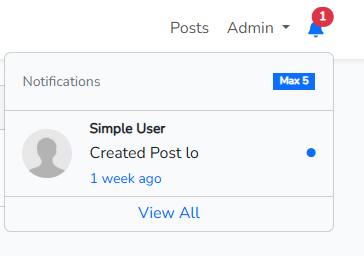usamaasif0 / notificano
Realtime notification package for Laravel using Reverb
Installs: 2
Dependents: 0
Suggesters: 0
Security: 0
Stars: 0
Watchers: 0
Forks: 0
pkg:composer/usamaasif0/notificano
Requires
- php: ^8.1
- illuminate/support: ^11.0|^12.0
- laravel/reverb: ^1.0
This package is auto-updated.
Last update: 2025-10-17 20:25:52 UTC
README
Notificano is a modern, open source, developer-friendly real-time notification system for Laravel. Built to leverage Laravel Reverb, Notificano is among the first (and most complete) open source packages to offer plug-and-play real-time notifications for Laravel applications. It provides a seamless, flexible, and robust solution for adding notification bells, unread counts, and notification lists to your app—without the hassle of building everything from scratch.
- First-class real-time notifications: Instantly notify users of new events, messages, or updates using Laravel Reverb.
- Easy integration: Add a notification bell and list to your layout with a single Blade directive.
- Flexible and customizable: Publish and override views, config, and assets as needed.
- Production-ready: Built for Laravel 11 and above, with best practices and extensibility in mind.
- Open source & community-driven: Licensed under MIT, Notificano welcomes issues, suggestions, and contributions from the Laravel community.
Notificano is one of the first comprehensive, open source real-time notification packages for Laravel using Reverb.
Features
- Real-time notifications (Laravel Reverb)
- Notification bell with unread count
- Notification list and mark-as-read functionality
- Publishable migrations, config, and assets
- Customizable via config
- Simple Blade directive:
@notificanoBell
View Examples
Notification Bell Example:

Notification List Page Example:
Prerequisites
Before installing Notificano, make sure your Laravel app has:
- Laravel Reverb installed and configured for real-time broadcasting.
- Broadcasting set up and working.
If you have not set up broadcasting and Reverb, run:
php artisan install:broadcasting
Follow the prompts to complete the setup. For more details, see the Laravel Reverb documentation.
Running Reverb and Frontend Assets
To enable real-time notifications, you must run the Reverb server:
php artisan reverb:start
If your project uses a frontend build system (like Vite or Laravel Mix), make sure to install dependencies and run the dev server:
npm install npm run dev
Keep both the Reverb server and your frontend dev server running during development for real-time updates.
Installation
1. Install the Package
Run the command:
composer require usamaasif0/notificano
2. Publish All Resources
Run:
php artisan vendor:publish --tag=notificano-all
3. Publish and Run Migrations
Run:
php artisan notificano:publish-migrations
User Model Setup
Add the following method to your User model (app/Models/User.php) to enable notification relationships:
public function notifications() { return $this->hasMany(\Notificano\Models\Notification::class, 'to_user'); }
Usage
1. Add the Notification Bell to Your Layout
Blade Directive (recommended):
@notificanoBell
2. Configuration
Publish and edit config/notificano.php to adjust settings (e.g., max notifications shown):
return [ 'max_notifications' => 5, ];
3. Sending Notifications Programmatically
You can send a notification from anywhere in your app using the setNotification helper:
- First parameter: An array of notification data (must include at least a 'title', can optionally include a 'url').
- Second parameter: The user ID to send the notification to (optional, defaults to 1 if not provided).
setNotification( ['title' => 'string (required)', 'url' => 'route name (optional)'], $toUserId // optional, defaults to user ID 1 );
title: The notification title (required)url: The route name or URL (optional)toUserId: The user ID to send the notification to (optional, defaults to 1)
4. Use Case Example
Here is an example of how you might use setNotification in a controller when a new post is created:
use Illuminate\Http\Request; public function store(Request $request) { // ... your logic to create a resource, e.g., a new post $post = Post::create($request->all()); // Send a notification to user with ID 5 setNotification([ 'title' => 'A new post was created!', 'url' => route('posts.show', $post->id) // optional ], 5); // ... rest of your controller logic }
Explanation:
- The first parameter is an array with at least a
'title'key. You can also include'url'or any other data your notification system uses. - The second parameter is the user ID you want to notify (in this example, user ID 5). If you omit it, the notification will be sent to user ID 1 by default.
Customization
- You can override the published views in your app's
resources/views/vendor/notificano/directory. - Change the default avatar image by replacing
public/images/no_avatar.webp.
Troubleshooting
- Notifications table missing? Run migrations after publishing.
- Not seeing the bell? Make sure you are logged in and have included
@notificanoBellin your layout. - Auth issues? Ensure your routes use both
webandauthmiddleware. - Custom user model? The package auto-detects your user model via Laravel config.
License
MIT
Contributing
Notificano is open source and welcomes contributions! If you have ideas, bug reports, or want to help improve the package, please open an issue or submit a pull request on GitHub.
Coding Standards & Contribution Guidelines
- Code Style: Please follow PSR-12 for all PHP code. Use camelCase for variables and methods, StudlyCase for classes, and UPPER_SNAKE_CASE for constants.
- Autoloading: All classes and files should follow PSR-4 autoloading standards. Place classes in the correct namespace and directory structure.
- Testing: If possible, add or update tests for your changes.
- Code Quality: Run code style checks and tests before submitting a pull request.
- Pull Requests: Clearly describe your changes and reference any related issues.
Thank you for helping make Notificano better!

